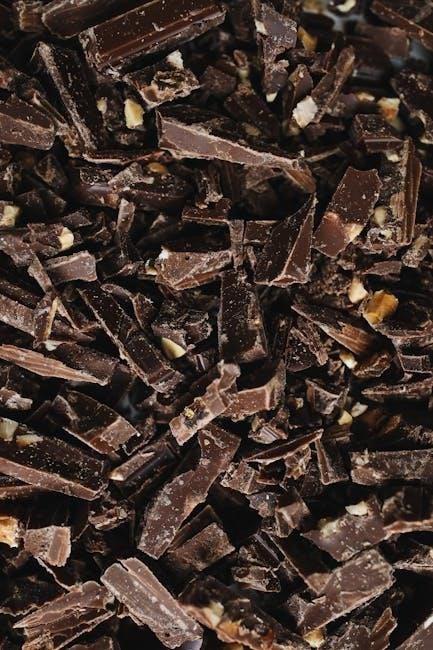Purine-Rich Foods and Uric Acid: An Overview
Purine-rich foods contribute to uric acid production during digestion․ Managing intake is crucial, especially for individuals with conditions like gout․ Identifying and limiting these foods helps control uric acid levels․

Understanding Purines and Uric Acid
Purines are natural substances found in many foods, and uric acid forms when the body breaks them down․ Elevated uric acid levels can lead to health issues, like gout and kidney disease․
What are Purines?
Purines are naturally occurring substances found in various foods we consume daily, and they are also produced within our bodies․ They are essentially chemical compounds that break down into uric acid․ This process is a normal part of metabolism․ However, high levels of purines in the diet can lead to elevated uric acid levels in the bloodstream․ These elevated levels can potentially crystallize and accumulate in joints, resulting in conditions like gout․ Therefore, understanding which foods are high in purines is crucial for managing uric acid levels and preventing related health complications, especially for those predisposed to gout or kidney issues․
How Purines Affect Uric Acid Levels
When the body digests foods containing purines, uric acid is produced as a waste product․ Normally, uric acid dissolves in the blood and is excreted through the kidneys via urine․ However, when excessive purine-rich foods are consumed, the kidneys may struggle to eliminate uric acid efficiently, leading to hyperuricemia․ This condition, characterized by high uric acid levels, can cause crystals to form and accumulate in joints, triggering painful gout attacks․ Therefore, managing purine intake is essential for maintaining healthy uric acid levels․ A balanced diet with limited high-purine foods reduces the risk of uric acid build-up and related health problems․
High Purine Foods to Avoid or Limit
Certain foods contain very high levels of purines, significantly impacting uric acid․ Limiting or avoiding these is crucial for managing gout and hyperuricemia․ Examples include organ meats and certain seafood․
Organ Meats
Organ meats, such as liver, kidneys, and sweetbreads, are exceptionally high in purines․ These should be strictly avoided or severely limited in a low-purine diet due to their significant impact on uric acid levels․ Calfs liver is one of the worst offenders․
Given their very high purine content, consuming organ meats can substantially elevate uric acid, increasing the risk of gout flare-ups․ Even small portions can trigger a significant increase in uric acid production․ Therefore, careful avoidance is typically recommended․
If you are prone to gout attacks, consider removing all organ meats from your diet to maintain healthy uric acid levels, consulting with a doctor is advisable․
Certain Seafood
Certain types of seafood are known to contain high levels of purines, contributing to elevated uric acid levels in the body․ Anchovies, sardines in oil, herring, mussels, scallops, and trout are among the seafood varieties that should be limited or avoided on a low-purine diet․
These seafood options can substantially increase uric acid production, potentially triggering gout flare-ups in susceptible individuals․ While seafood can be a healthy part of a balanced diet, moderation is crucial for those managing uric acid levels․
Selecting low-purine alternatives and monitoring portion sizes are important strategies for enjoying seafood without exacerbating gout symptoms; Consulting a dietitian is advisable․
High-Fructose Foods
High-fructose foods can indirectly elevate uric acid levels․ Fructose metabolism leads to purine breakdown, subsequently increasing uric acid production․ Foods and beverages sweetened with high-fructose corn syrup are major contributors․ Sugary sodas, processed snacks, and certain fruit juices are examples to limit․
Excessive fructose consumption can exacerbate hyperuricemia and increase the risk of gout․ Unlike purines directly found in foods, fructose triggers a metabolic pathway that promotes uric acid synthesis․ Choosing natural sweeteners and reducing intake of processed foods is advisable․
Reading labels carefully and opting for whole, unprocessed options helps minimize fructose intake and manage uric acid levels․ Consulting a healthcare professional can provide personalized dietary guidance․

Moderate Purine Foods: Occasional Consumption
Moderate purine foods can be included in the diet occasionally․ These foods have a lower purine content than high-purine options․ Portion control is key to managing uric acid levels․
Meat and Fish (Excluding High Purine)
Certain meats and fish, excluding those high in purines, fall into the moderate category․ This includes poultry and some types of fish․ These can be consumed in moderation as part of a balanced diet, especially for individuals managing uric acid levels․ It is important to limit portion sizes to around 4 to 6 ounces per day to avoid elevated uric acid levels․ Choosing lower-fat options can provide additional health benefits․ Always consider individual tolerance and consult with a healthcare professional or registered dietitian for personalized dietary recommendations․ Be mindful of preparation methods, as added fats and sauces can impact overall health․ Prioritize lean cuts and cooking methods like baking or grilling․
Shellfish
Shellfish, including shrimp, crab, and lobster, generally contain moderate levels of purines․ Therefore, their consumption should be occasional for individuals monitoring uric acid․ While not as high in purines as organ meats, shellfish can still contribute to increased uric acid levels in the body․ Portion control is crucial; limiting servings can minimize the impact․ Preparation methods also matter; avoid frying or adding rich sauces․ Consider steaming or grilling to reduce added fats․ Individuals with gout or hyperuricemia should consult with a healthcare provider or registered dietitian for specific guidance on shellfish consumption․ Monitoring uric acid levels is important to assess individual tolerance and make informed dietary choices․
Vegetables (Asparagus, Mushrooms, Spinach, Peas, Lentils)
Certain vegetables, such as asparagus, mushrooms, spinach, peas, and lentils, contain moderate amounts of purines․ Despite their purine content, studies suggest these vegetables do not significantly elevate uric acid levels or increase gout risk compared to meat and seafood․ The purines in vegetables seem to have a different metabolic effect․ These vegetables offer essential nutrients and fiber, contributing to overall health․ Moderate consumption is generally considered safe, even for individuals with gout․ Dietary guidelines often emphasize the importance of including a variety of vegetables․ However, individual responses may vary, and monitoring uric acid levels can provide personalized insights․ Consulting a healthcare professional is always recommended for tailored dietary advice․
Low Purine Foods: Suitable for Daily Intake
A variety of foods are naturally low in purines, making them suitable for daily consumption and ideal for managing uric acid levels․ These include most fruits, offering a wide range of vitamins and antioxidants beneficial for overall health․ Many vegetables beyond the moderate purine group are also included, promoting balanced nutrition․ Refined grains like white rice and pasta fall into this category, providing carbohydrates for energy․ Dairy products, especially low-fat options, are generally low in purines and can be included regularly․ Nuts and seeds, in moderation, also offer healthy fats and protein without significantly impacting uric acid․ Prioritizing these foods supports a balanced diet․ Individuals can enjoy these foods without concern for elevated uric acid levels․ Always consult with a healthcare professional․

Debunking Myths: Vegetables and Purines
Despite some vegetables containing purines, studies suggest they don’t significantly elevate gout risk compared to meat․ The impact varies, highlighting the importance of balanced dietary choices and professional guidance․
Spinach, Asparagus, and Gout Risk
Contrary to popular belief, vegetables like spinach and asparagus, although containing purines, aren’t strongly linked to increased gout risk․ Research indicates that purines from vegetable sources have a different impact compared to those from meat and seafood․ These vegetables offer various health benefits and can be part of a balanced diet, even for individuals managing uric acid levels․ Studies show that the purines in these vegetables are less likely to cause gout flare-ups than purines found in animal products․ Therefore, limiting meat and seafood is generally more important than restricting these nutritious vegetables․ Always consult a healthcare professional for personalized dietary advice regarding gout and purine intake․

Dietary Recommendations for Managing Uric Acid
Managing uric acid involves dietary adjustments․ Prioritize low-purine foods, limit moderate-purine options, and avoid high-purine sources․ This approach helps in controlling uric acid levels and reducing the risk of gout attacks․
Prioritize Low-Purine Foods
Incorporating low-purine foods into your daily diet is essential for managing uric acid levels․ Focus on fruits, vegetables (excluding high-purine ones), and whole grains․ These foods have minimal impact on uric acid production․ Dairy products, although containing purines, may actually help reduce uric acid build-up․
Choose low-fat options like nuts, soya, eggs, or low-fat cheese as vegetable sources of protein․ A balanced intake, ensuring no more than two servings of protein per day, supports overall health․ Prioritizing these foods helps maintain lower uric acid levels․
Limit Moderate-Purine Foods
Moderate-purine foods should be consumed occasionally, not daily, especially for individuals managing gout․ This category includes certain meats, fish, shellfish, and some vegetables like asparagus, mushrooms, spinach, peas, and lentils․ Portion control is vital when including these foods in your diet․
Aim for no more than 4 to 6 ounces of meat or fish per day․ Consider reducing frequency to two to three times per week․ Balancing these foods with low-purine options helps maintain healthy uric acid levels․ Always drink water before and after consuming these foods․
Avoid High-Purine Foods
High-purine foods should be strictly avoided, especially for those with gout or high uric acid levels․ This category includes organ meats like liver and kidney, certain seafood such as anchovies, sardines, and mussels, and high-fructose foods․
These foods significantly elevate uric acid levels, increasing the risk of gout attacks․ Eliminating these items from your diet can substantially improve your condition․ If you occasionally consume these, drink plenty of water․ Always consult with a doctor or registered dietitian for personalized dietary advice․